Corporate Accounting: Financial Reporting, Analysis & Regulations
VerifiedAdded on 2023/06/05
|14
|2798
|417
Report
AI Summary
This report provides an overview of corporate accounting regulations and the importance of transparent financial reporting. It discusses the role of accounting standard-setting bodies like AASB and IFRS in ensuring the quality of financial statements. The report also examines the concept of voluntary disclosures and their impact on a company's reputation and competitive advantage. Furthermore, a comparative analysis of the debt and equity structure of four public-listed companies in the Australian mining industry (BHP Billiton, Orica Limited, Rio Tinto, and Fortescue) is presented, evaluating their financial performance and stability based on key financial ratios like the debt-to-equity ratio. Desklib provides this report as a student resource.
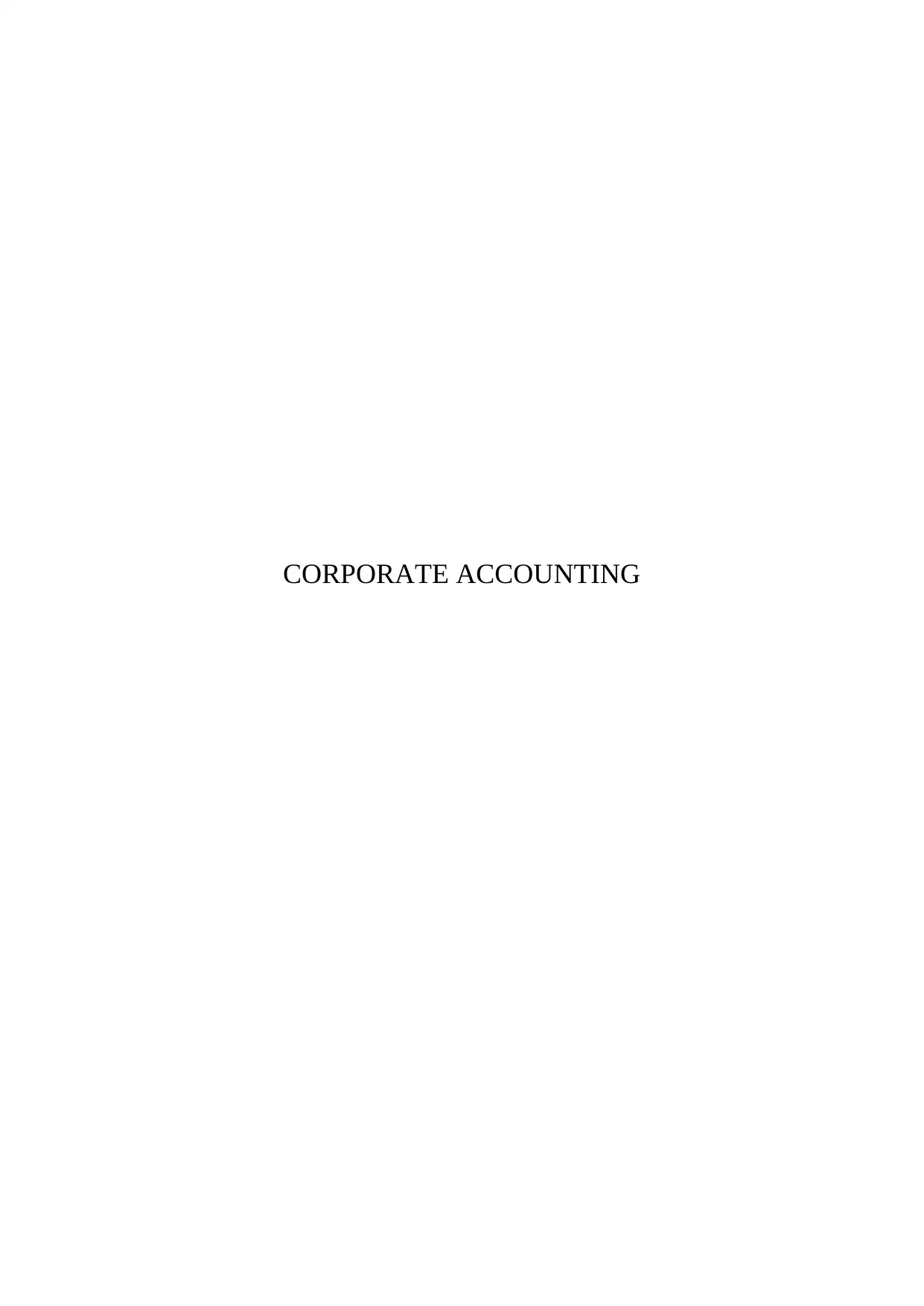
CORPORATE ACCOUNTING
Paraphrase This Document
Need a fresh take? Get an instant paraphrase of this document with our AI Paraphraser
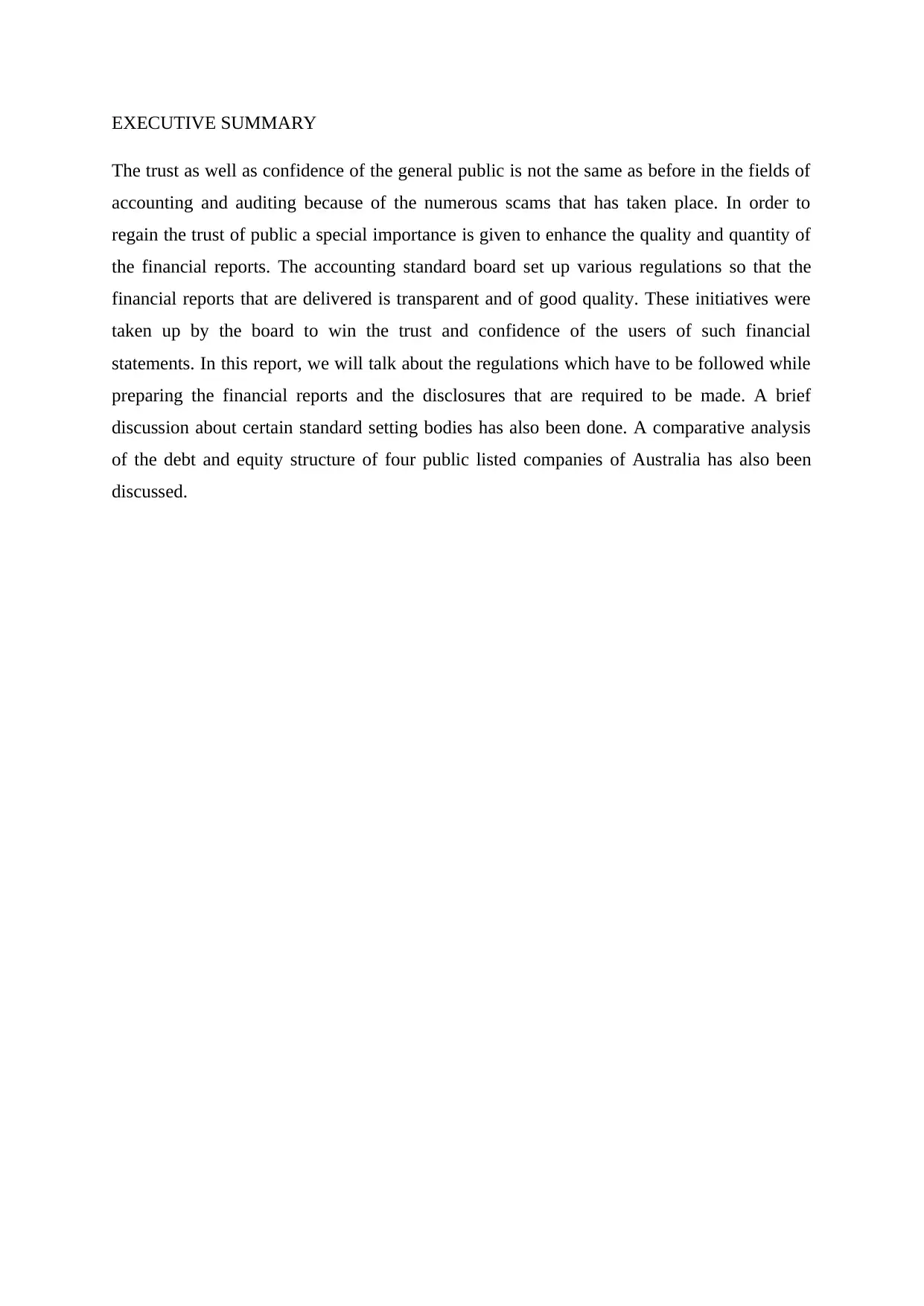
EXECUTIVE SUMMARY
The trust as well as confidence of the general public is not the same as before in the fields of
accounting and auditing because of the numerous scams that has taken place. In order to
regain the trust of public a special importance is given to enhance the quality and quantity of
the financial reports. The accounting standard board set up various regulations so that the
financial reports that are delivered is transparent and of good quality. These initiatives were
taken up by the board to win the trust and confidence of the users of such financial
statements. In this report, we will talk about the regulations which have to be followed while
preparing the financial reports and the disclosures that are required to be made. A brief
discussion about certain standard setting bodies has also been done. A comparative analysis
of the debt and equity structure of four public listed companies of Australia has also been
discussed.
The trust as well as confidence of the general public is not the same as before in the fields of
accounting and auditing because of the numerous scams that has taken place. In order to
regain the trust of public a special importance is given to enhance the quality and quantity of
the financial reports. The accounting standard board set up various regulations so that the
financial reports that are delivered is transparent and of good quality. These initiatives were
taken up by the board to win the trust and confidence of the users of such financial
statements. In this report, we will talk about the regulations which have to be followed while
preparing the financial reports and the disclosures that are required to be made. A brief
discussion about certain standard setting bodies has also been done. A comparative analysis
of the debt and equity structure of four public listed companies of Australia has also been
discussed.
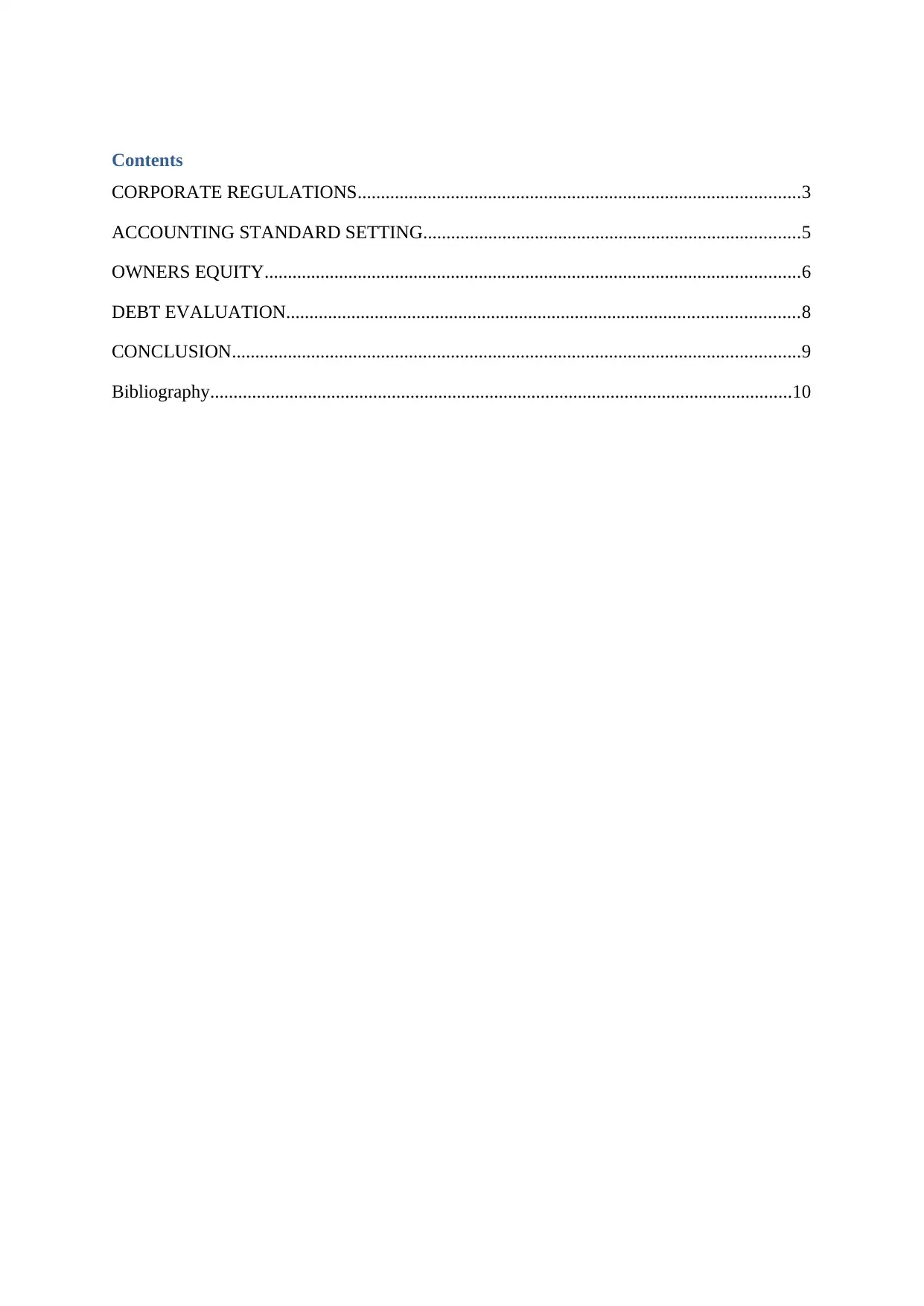
Contents
CORPORATE REGULATIONS...............................................................................................3
ACCOUNTING STANDARD SETTING.................................................................................5
OWNERS EQUITY...................................................................................................................6
DEBT EVALUATION..............................................................................................................8
CONCLUSION..........................................................................................................................9
Bibliography.............................................................................................................................10
CORPORATE REGULATIONS...............................................................................................3
ACCOUNTING STANDARD SETTING.................................................................................5
OWNERS EQUITY...................................................................................................................6
DEBT EVALUATION..............................................................................................................8
CONCLUSION..........................................................................................................................9
Bibliography.............................................................................................................................10
⊘ This is a preview!⊘
Do you want full access?
Subscribe today to unlock all pages.

Trusted by 1+ million students worldwide
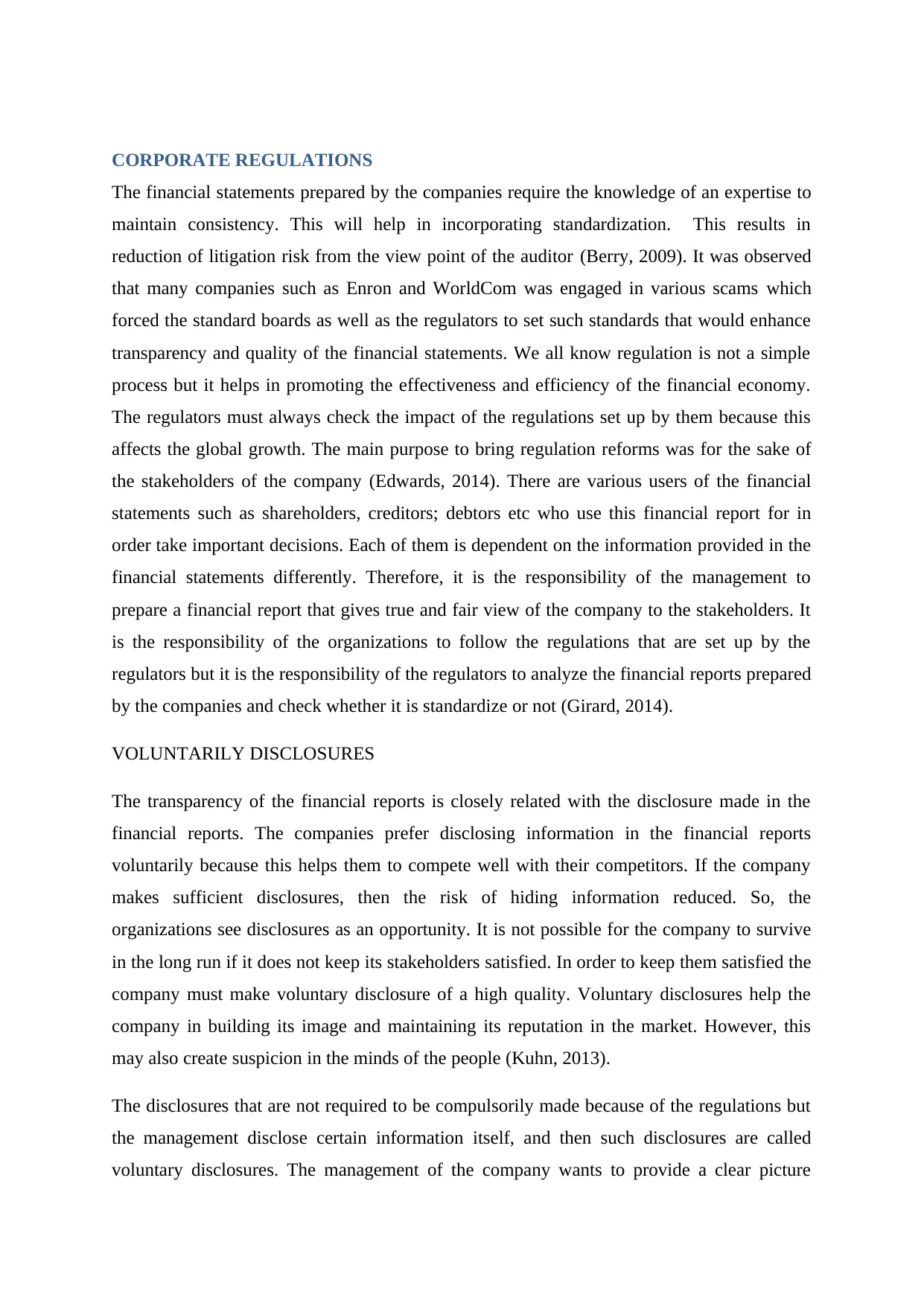
CORPORATE REGULATIONS
The financial statements prepared by the companies require the knowledge of an expertise to
maintain consistency. This will help in incorporating standardization. This results in
reduction of litigation risk from the view point of the auditor (Berry, 2009). It was observed
that many companies such as Enron and WorldCom was engaged in various scams which
forced the standard boards as well as the regulators to set such standards that would enhance
transparency and quality of the financial statements. We all know regulation is not a simple
process but it helps in promoting the effectiveness and efficiency of the financial economy.
The regulators must always check the impact of the regulations set up by them because this
affects the global growth. The main purpose to bring regulation reforms was for the sake of
the stakeholders of the company (Edwards, 2014). There are various users of the financial
statements such as shareholders, creditors; debtors etc who use this financial report for in
order take important decisions. Each of them is dependent on the information provided in the
financial statements differently. Therefore, it is the responsibility of the management to
prepare a financial report that gives true and fair view of the company to the stakeholders. It
is the responsibility of the organizations to follow the regulations that are set up by the
regulators but it is the responsibility of the regulators to analyze the financial reports prepared
by the companies and check whether it is standardize or not (Girard, 2014).
VOLUNTARILY DISCLOSURES
The transparency of the financial reports is closely related with the disclosure made in the
financial reports. The companies prefer disclosing information in the financial reports
voluntarily because this helps them to compete well with their competitors. If the company
makes sufficient disclosures, then the risk of hiding information reduced. So, the
organizations see disclosures as an opportunity. It is not possible for the company to survive
in the long run if it does not keep its stakeholders satisfied. In order to keep them satisfied the
company must make voluntary disclosure of a high quality. Voluntary disclosures help the
company in building its image and maintaining its reputation in the market. However, this
may also create suspicion in the minds of the people (Kuhn, 2013).
The disclosures that are not required to be compulsorily made because of the regulations but
the management disclose certain information itself, and then such disclosures are called
voluntary disclosures. The management of the company wants to provide a clear picture
The financial statements prepared by the companies require the knowledge of an expertise to
maintain consistency. This will help in incorporating standardization. This results in
reduction of litigation risk from the view point of the auditor (Berry, 2009). It was observed
that many companies such as Enron and WorldCom was engaged in various scams which
forced the standard boards as well as the regulators to set such standards that would enhance
transparency and quality of the financial statements. We all know regulation is not a simple
process but it helps in promoting the effectiveness and efficiency of the financial economy.
The regulators must always check the impact of the regulations set up by them because this
affects the global growth. The main purpose to bring regulation reforms was for the sake of
the stakeholders of the company (Edwards, 2014). There are various users of the financial
statements such as shareholders, creditors; debtors etc who use this financial report for in
order take important decisions. Each of them is dependent on the information provided in the
financial statements differently. Therefore, it is the responsibility of the management to
prepare a financial report that gives true and fair view of the company to the stakeholders. It
is the responsibility of the organizations to follow the regulations that are set up by the
regulators but it is the responsibility of the regulators to analyze the financial reports prepared
by the companies and check whether it is standardize or not (Girard, 2014).
VOLUNTARILY DISCLOSURES
The transparency of the financial reports is closely related with the disclosure made in the
financial reports. The companies prefer disclosing information in the financial reports
voluntarily because this helps them to compete well with their competitors. If the company
makes sufficient disclosures, then the risk of hiding information reduced. So, the
organizations see disclosures as an opportunity. It is not possible for the company to survive
in the long run if it does not keep its stakeholders satisfied. In order to keep them satisfied the
company must make voluntary disclosure of a high quality. Voluntary disclosures help the
company in building its image and maintaining its reputation in the market. However, this
may also create suspicion in the minds of the people (Kuhn, 2013).
The disclosures that are not required to be compulsorily made because of the regulations but
the management disclose certain information itself, and then such disclosures are called
voluntary disclosures. The management of the company wants to provide a clear picture
Paraphrase This Document
Need a fresh take? Get an instant paraphrase of this document with our AI Paraphraser
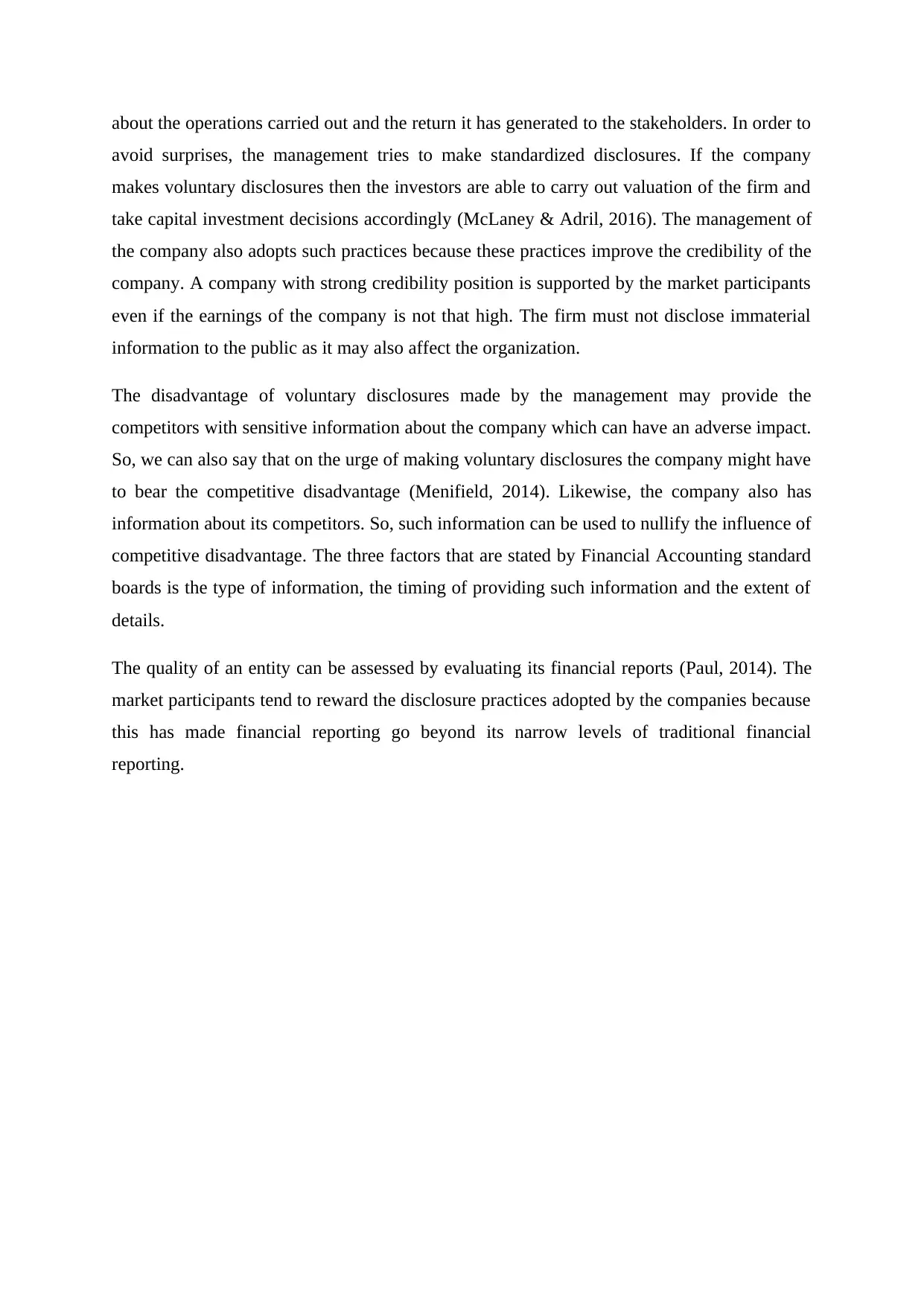
about the operations carried out and the return it has generated to the stakeholders. In order to
avoid surprises, the management tries to make standardized disclosures. If the company
makes voluntary disclosures then the investors are able to carry out valuation of the firm and
take capital investment decisions accordingly (McLaney & Adril, 2016). The management of
the company also adopts such practices because these practices improve the credibility of the
company. A company with strong credibility position is supported by the market participants
even if the earnings of the company is not that high. The firm must not disclose immaterial
information to the public as it may also affect the organization.
The disadvantage of voluntary disclosures made by the management may provide the
competitors with sensitive information about the company which can have an adverse impact.
So, we can also say that on the urge of making voluntary disclosures the company might have
to bear the competitive disadvantage (Menifield, 2014). Likewise, the company also has
information about its competitors. So, such information can be used to nullify the influence of
competitive disadvantage. The three factors that are stated by Financial Accounting standard
boards is the type of information, the timing of providing such information and the extent of
details.
The quality of an entity can be assessed by evaluating its financial reports (Paul, 2014). The
market participants tend to reward the disclosure practices adopted by the companies because
this has made financial reporting go beyond its narrow levels of traditional financial
reporting.
avoid surprises, the management tries to make standardized disclosures. If the company
makes voluntary disclosures then the investors are able to carry out valuation of the firm and
take capital investment decisions accordingly (McLaney & Adril, 2016). The management of
the company also adopts such practices because these practices improve the credibility of the
company. A company with strong credibility position is supported by the market participants
even if the earnings of the company is not that high. The firm must not disclose immaterial
information to the public as it may also affect the organization.
The disadvantage of voluntary disclosures made by the management may provide the
competitors with sensitive information about the company which can have an adverse impact.
So, we can also say that on the urge of making voluntary disclosures the company might have
to bear the competitive disadvantage (Menifield, 2014). Likewise, the company also has
information about its competitors. So, such information can be used to nullify the influence of
competitive disadvantage. The three factors that are stated by Financial Accounting standard
boards is the type of information, the timing of providing such information and the extent of
details.
The quality of an entity can be assessed by evaluating its financial reports (Paul, 2014). The
market participants tend to reward the disclosure practices adopted by the companies because
this has made financial reporting go beyond its narrow levels of traditional financial
reporting.
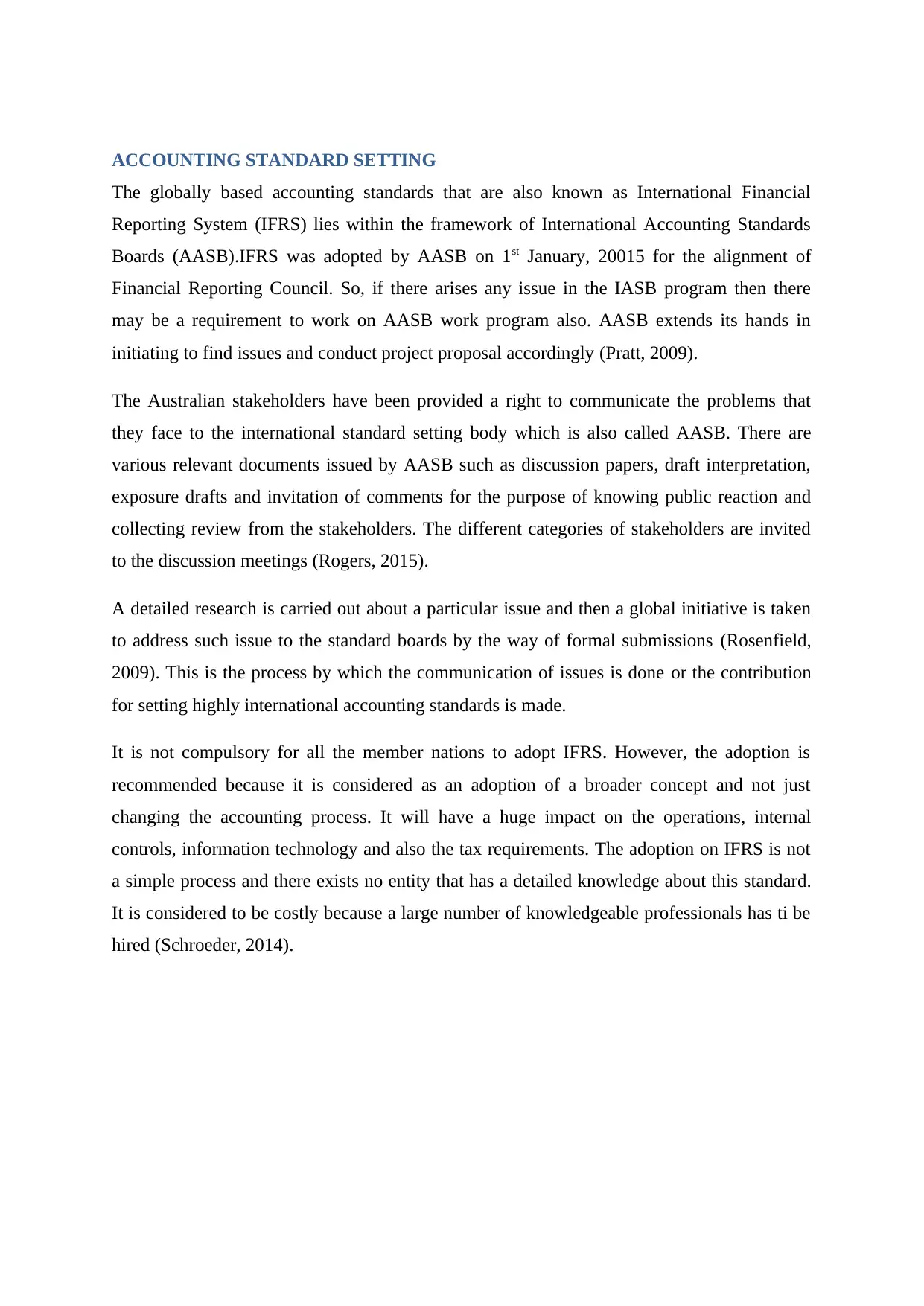
ACCOUNTING STANDARD SETTING
The globally based accounting standards that are also known as International Financial
Reporting System (IFRS) lies within the framework of International Accounting Standards
Boards (AASB).IFRS was adopted by AASB on 1st January, 20015 for the alignment of
Financial Reporting Council. So, if there arises any issue in the IASB program then there
may be a requirement to work on AASB work program also. AASB extends its hands in
initiating to find issues and conduct project proposal accordingly (Pratt, 2009).
The Australian stakeholders have been provided a right to communicate the problems that
they face to the international standard setting body which is also called AASB. There are
various relevant documents issued by AASB such as discussion papers, draft interpretation,
exposure drafts and invitation of comments for the purpose of knowing public reaction and
collecting review from the stakeholders. The different categories of stakeholders are invited
to the discussion meetings (Rogers, 2015).
A detailed research is carried out about a particular issue and then a global initiative is taken
to address such issue to the standard boards by the way of formal submissions (Rosenfield,
2009). This is the process by which the communication of issues is done or the contribution
for setting highly international accounting standards is made.
It is not compulsory for all the member nations to adopt IFRS. However, the adoption is
recommended because it is considered as an adoption of a broader concept and not just
changing the accounting process. It will have a huge impact on the operations, internal
controls, information technology and also the tax requirements. The adoption on IFRS is not
a simple process and there exists no entity that has a detailed knowledge about this standard.
It is considered to be costly because a large number of knowledgeable professionals has ti be
hired (Schroeder, 2014).
The globally based accounting standards that are also known as International Financial
Reporting System (IFRS) lies within the framework of International Accounting Standards
Boards (AASB).IFRS was adopted by AASB on 1st January, 20015 for the alignment of
Financial Reporting Council. So, if there arises any issue in the IASB program then there
may be a requirement to work on AASB work program also. AASB extends its hands in
initiating to find issues and conduct project proposal accordingly (Pratt, 2009).
The Australian stakeholders have been provided a right to communicate the problems that
they face to the international standard setting body which is also called AASB. There are
various relevant documents issued by AASB such as discussion papers, draft interpretation,
exposure drafts and invitation of comments for the purpose of knowing public reaction and
collecting review from the stakeholders. The different categories of stakeholders are invited
to the discussion meetings (Rogers, 2015).
A detailed research is carried out about a particular issue and then a global initiative is taken
to address such issue to the standard boards by the way of formal submissions (Rosenfield,
2009). This is the process by which the communication of issues is done or the contribution
for setting highly international accounting standards is made.
It is not compulsory for all the member nations to adopt IFRS. However, the adoption is
recommended because it is considered as an adoption of a broader concept and not just
changing the accounting process. It will have a huge impact on the operations, internal
controls, information technology and also the tax requirements. The adoption on IFRS is not
a simple process and there exists no entity that has a detailed knowledge about this standard.
It is considered to be costly because a large number of knowledgeable professionals has ti be
hired (Schroeder, 2014).
⊘ This is a preview!⊘
Do you want full access?
Subscribe today to unlock all pages.

Trusted by 1+ million students worldwide
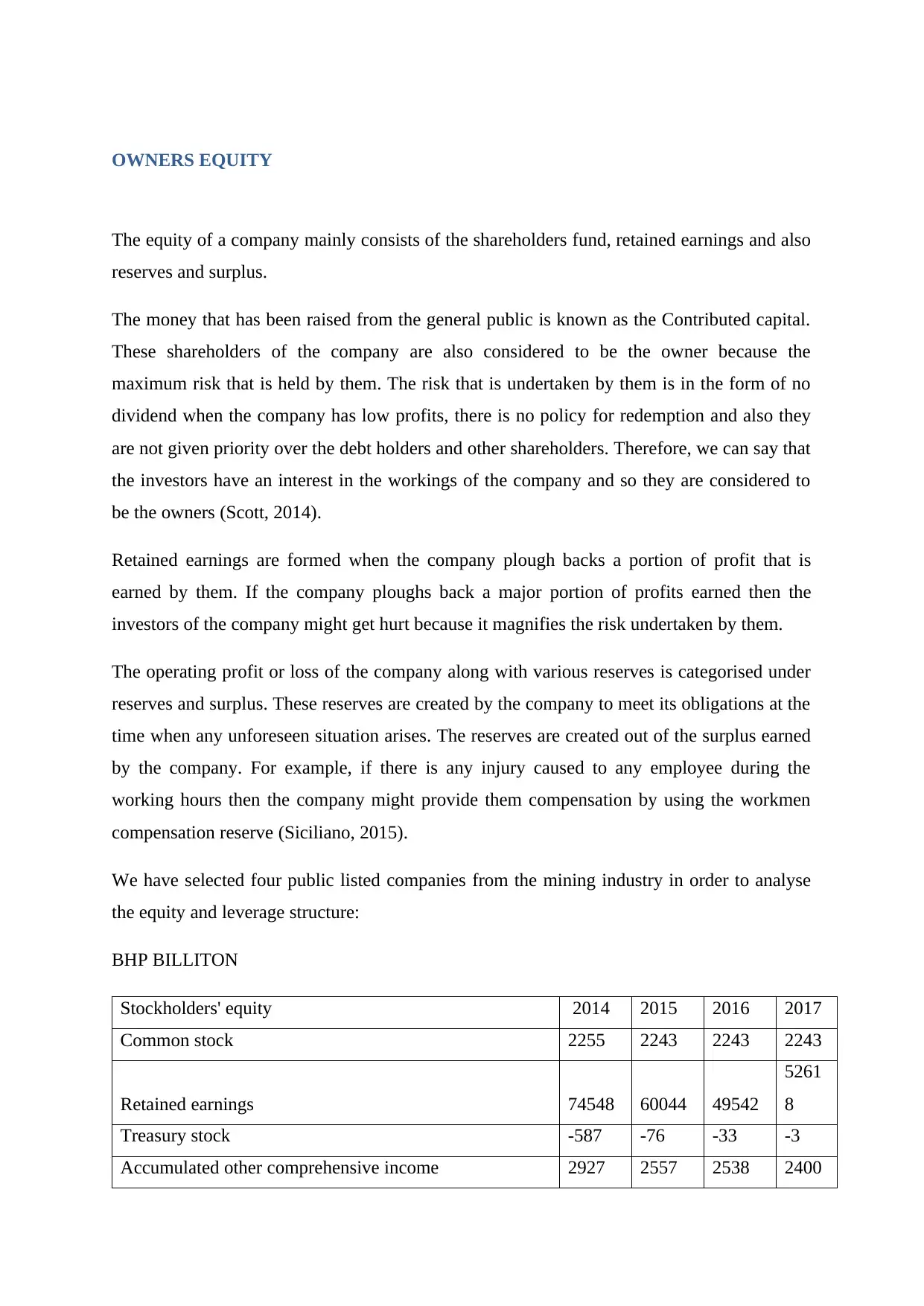
OWNERS EQUITY
The equity of a company mainly consists of the shareholders fund, retained earnings and also
reserves and surplus.
The money that has been raised from the general public is known as the Contributed capital.
These shareholders of the company are also considered to be the owner because the
maximum risk that is held by them. The risk that is undertaken by them is in the form of no
dividend when the company has low profits, there is no policy for redemption and also they
are not given priority over the debt holders and other shareholders. Therefore, we can say that
the investors have an interest in the workings of the company and so they are considered to
be the owners (Scott, 2014).
Retained earnings are formed when the company plough backs a portion of profit that is
earned by them. If the company ploughs back a major portion of profits earned then the
investors of the company might get hurt because it magnifies the risk undertaken by them.
The operating profit or loss of the company along with various reserves is categorised under
reserves and surplus. These reserves are created by the company to meet its obligations at the
time when any unforeseen situation arises. The reserves are created out of the surplus earned
by the company. For example, if there is any injury caused to any employee during the
working hours then the company might provide them compensation by using the workmen
compensation reserve (Siciliano, 2015).
We have selected four public listed companies from the mining industry in order to analyse
the equity and leverage structure:
BHP BILLITON
Stockholders' equity 2014 2015 2016 2017
Common stock 2255 2243 2243 2243
Retained earnings 74548 60044 49542
5261
8
Treasury stock -587 -76 -33 -3
Accumulated other comprehensive income 2927 2557 2538 2400
The equity of a company mainly consists of the shareholders fund, retained earnings and also
reserves and surplus.
The money that has been raised from the general public is known as the Contributed capital.
These shareholders of the company are also considered to be the owner because the
maximum risk that is held by them. The risk that is undertaken by them is in the form of no
dividend when the company has low profits, there is no policy for redemption and also they
are not given priority over the debt holders and other shareholders. Therefore, we can say that
the investors have an interest in the workings of the company and so they are considered to
be the owners (Scott, 2014).
Retained earnings are formed when the company plough backs a portion of profit that is
earned by them. If the company ploughs back a major portion of profits earned then the
investors of the company might get hurt because it magnifies the risk undertaken by them.
The operating profit or loss of the company along with various reserves is categorised under
reserves and surplus. These reserves are created by the company to meet its obligations at the
time when any unforeseen situation arises. The reserves are created out of the surplus earned
by the company. For example, if there is any injury caused to any employee during the
working hours then the company might provide them compensation by using the workmen
compensation reserve (Siciliano, 2015).
We have selected four public listed companies from the mining industry in order to analyse
the equity and leverage structure:
BHP BILLITON
Stockholders' equity 2014 2015 2016 2017
Common stock 2255 2243 2243 2243
Retained earnings 74548 60044 49542
5261
8
Treasury stock -587 -76 -33 -3
Accumulated other comprehensive income 2927 2557 2538 2400
Paraphrase This Document
Need a fresh take? Get an instant paraphrase of this document with our AI Paraphraser

Total Stockholders' equity 79143 64768 54290
5725
8
We can observe in the table above, there has been a downfall over the past four years. This
might lead to degradation in the market position. On analysing, we have found out that this
downfall occurred because the reserves of the company reduced substantially as the company
exercised employee share awards (Taillard, 2013).
ORICA LIMITED
Stockholders' equity 2014 2015 2016
201
7
Common stock 1975 1954 2025
206
8
Other Equity -70 -147 -149 -123
Retained earnings 2895 1247 1247
146
0
Accumulated other comprehensive income -537 -70 -341 -443
Total stockholders' equity 4263 2985 2782
296
2
From the above table, we can observe that the equity of the company is falling continuously
over the years. On analysing, we think that the reason for it is the huge expenditure on the
material costs of the existing contracts that are held by the company. There is also a positive
point indicated from the above table which is the maintenance of the level of retained
earnings of the company. This is because the profits earned in the previous years were
reinvested (Warren, 2017).
RIO TINTO
Stockholders' equity 2014 2015 2016 2017
Additional paid-in capital 9053 8474 8443 8666
Retained earnings 26110 19736 21631
2376
1
Accumulated other comprehensive income 11122 9139 9216 1228
5725
8
We can observe in the table above, there has been a downfall over the past four years. This
might lead to degradation in the market position. On analysing, we have found out that this
downfall occurred because the reserves of the company reduced substantially as the company
exercised employee share awards (Taillard, 2013).
ORICA LIMITED
Stockholders' equity 2014 2015 2016
201
7
Common stock 1975 1954 2025
206
8
Other Equity -70 -147 -149 -123
Retained earnings 2895 1247 1247
146
0
Accumulated other comprehensive income -537 -70 -341 -443
Total stockholders' equity 4263 2985 2782
296
2
From the above table, we can observe that the equity of the company is falling continuously
over the years. On analysing, we think that the reason for it is the huge expenditure on the
material costs of the existing contracts that are held by the company. There is also a positive
point indicated from the above table which is the maintenance of the level of retained
earnings of the company. This is because the profits earned in the previous years were
reinvested (Warren, 2017).
RIO TINTO
Stockholders' equity 2014 2015 2016 2017
Additional paid-in capital 9053 8474 8443 8666
Retained earnings 26110 19736 21631
2376
1
Accumulated other comprehensive income 11122 9139 9216 1228
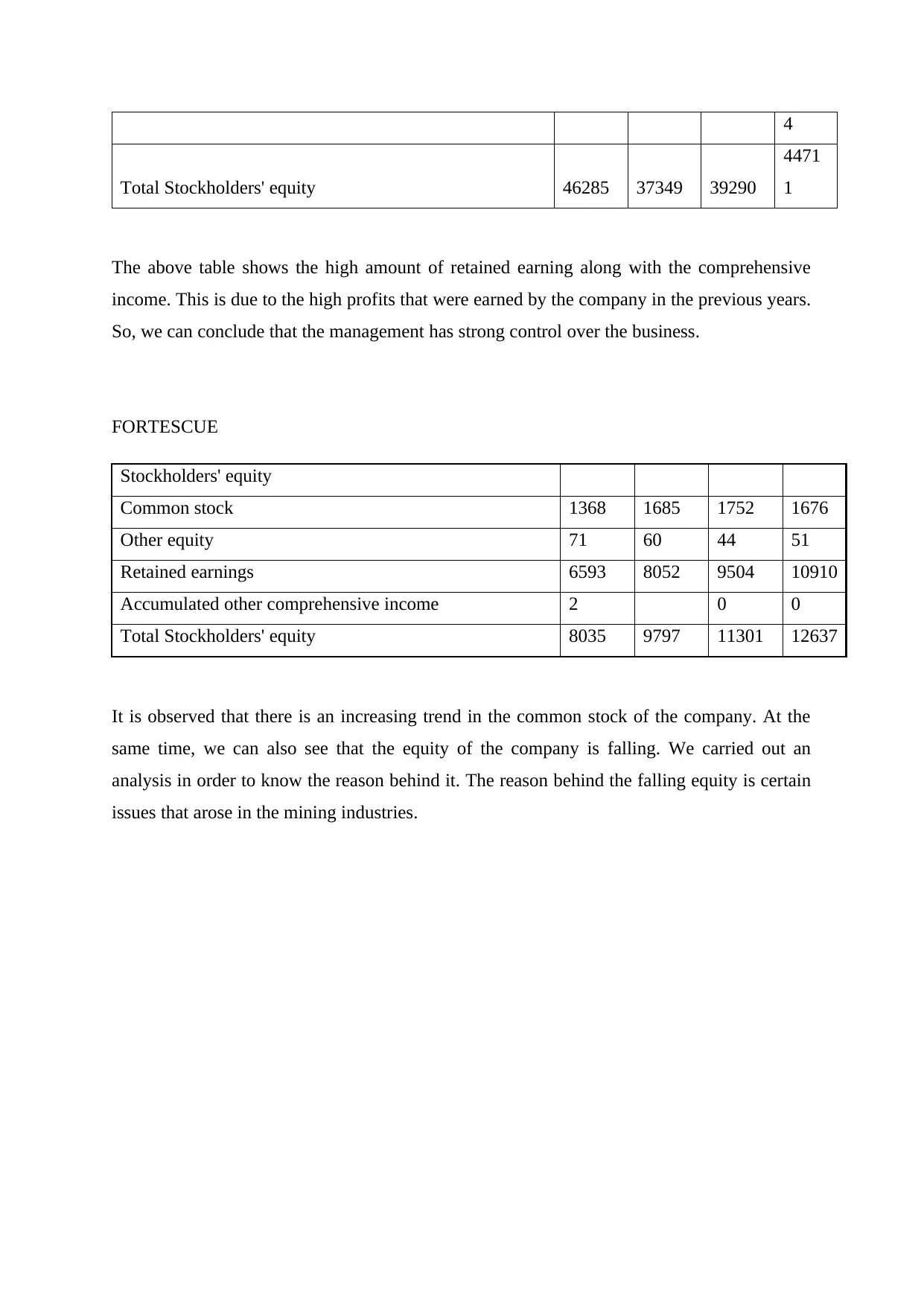
4
Total Stockholders' equity 46285 37349 39290
4471
1
The above table shows the high amount of retained earning along with the comprehensive
income. This is due to the high profits that were earned by the company in the previous years.
So, we can conclude that the management has strong control over the business.
FORTESCUE
Stockholders' equity
Common stock 1368 1685 1752 1676
Other equity 71 60 44 51
Retained earnings 6593 8052 9504 10910
Accumulated other comprehensive income 2 0 0
Total Stockholders' equity 8035 9797 11301 12637
It is observed that there is an increasing trend in the common stock of the company. At the
same time, we can also see that the equity of the company is falling. We carried out an
analysis in order to know the reason behind it. The reason behind the falling equity is certain
issues that arose in the mining industries.
Total Stockholders' equity 46285 37349 39290
4471
1
The above table shows the high amount of retained earning along with the comprehensive
income. This is due to the high profits that were earned by the company in the previous years.
So, we can conclude that the management has strong control over the business.
FORTESCUE
Stockholders' equity
Common stock 1368 1685 1752 1676
Other equity 71 60 44 51
Retained earnings 6593 8052 9504 10910
Accumulated other comprehensive income 2 0 0
Total Stockholders' equity 8035 9797 11301 12637
It is observed that there is an increasing trend in the common stock of the company. At the
same time, we can also see that the equity of the company is falling. We carried out an
analysis in order to know the reason behind it. The reason behind the falling equity is certain
issues that arose in the mining industries.
⊘ This is a preview!⊘
Do you want full access?
Subscribe today to unlock all pages.

Trusted by 1+ million students worldwide
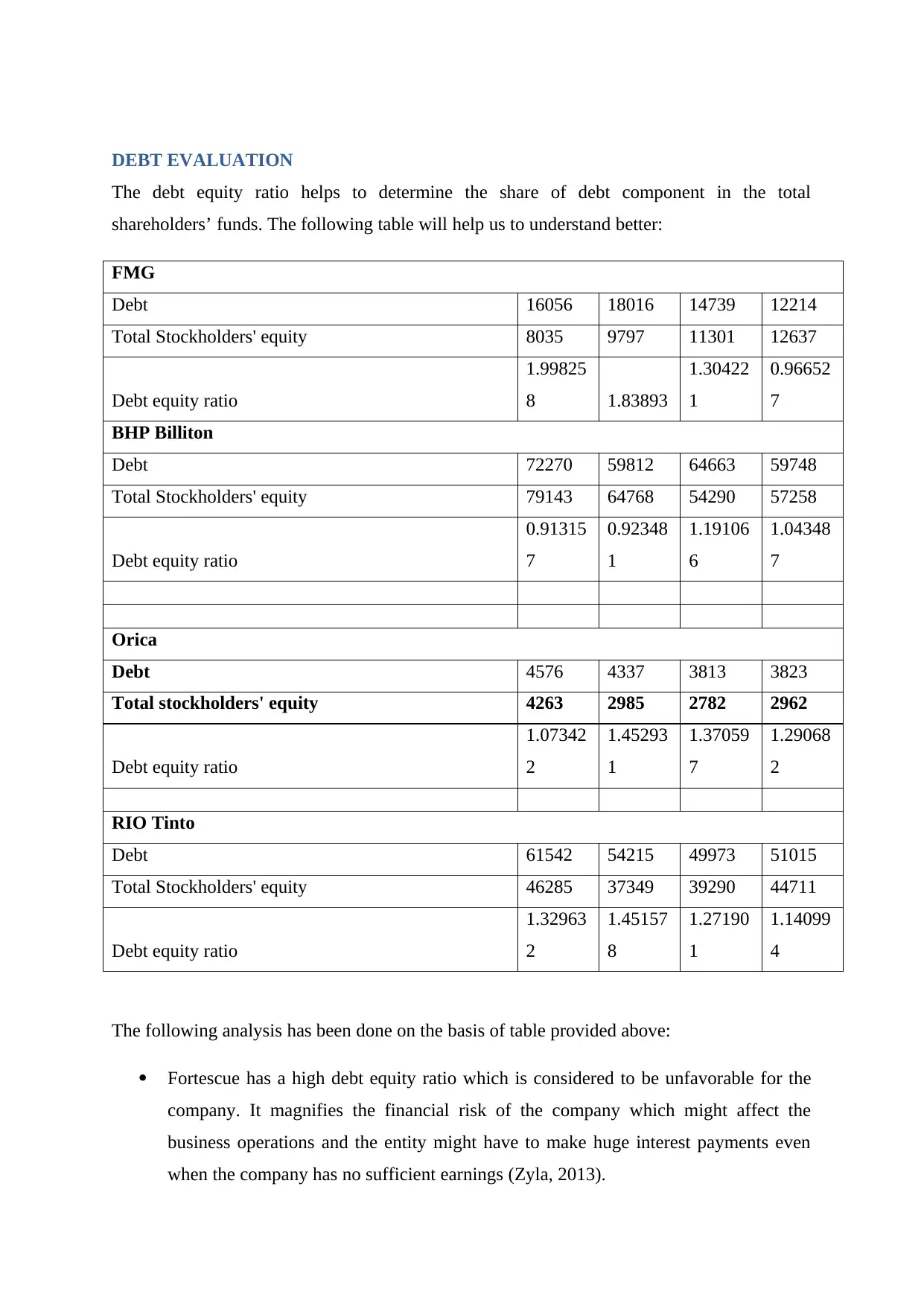
DEBT EVALUATION
The debt equity ratio helps to determine the share of debt component in the total
shareholders’ funds. The following table will help us to understand better:
FMG
Debt 16056 18016 14739 12214
Total Stockholders' equity 8035 9797 11301 12637
Debt equity ratio
1.99825
8 1.83893
1.30422
1
0.96652
7
BHP Billiton
Debt 72270 59812 64663 59748
Total Stockholders' equity 79143 64768 54290 57258
Debt equity ratio
0.91315
7
0.92348
1
1.19106
6
1.04348
7
Orica
Debt 4576 4337 3813 3823
Total stockholders' equity 4263 2985 2782 2962
Debt equity ratio
1.07342
2
1.45293
1
1.37059
7
1.29068
2
RIO Tinto
Debt 61542 54215 49973 51015
Total Stockholders' equity 46285 37349 39290 44711
Debt equity ratio
1.32963
2
1.45157
8
1.27190
1
1.14099
4
The following analysis has been done on the basis of table provided above:
Fortescue has a high debt equity ratio which is considered to be unfavorable for the
company. It magnifies the financial risk of the company which might affect the
business operations and the entity might have to make huge interest payments even
when the company has no sufficient earnings (Zyla, 2013).
The debt equity ratio helps to determine the share of debt component in the total
shareholders’ funds. The following table will help us to understand better:
FMG
Debt 16056 18016 14739 12214
Total Stockholders' equity 8035 9797 11301 12637
Debt equity ratio
1.99825
8 1.83893
1.30422
1
0.96652
7
BHP Billiton
Debt 72270 59812 64663 59748
Total Stockholders' equity 79143 64768 54290 57258
Debt equity ratio
0.91315
7
0.92348
1
1.19106
6
1.04348
7
Orica
Debt 4576 4337 3813 3823
Total stockholders' equity 4263 2985 2782 2962
Debt equity ratio
1.07342
2
1.45293
1
1.37059
7
1.29068
2
RIO Tinto
Debt 61542 54215 49973 51015
Total Stockholders' equity 46285 37349 39290 44711
Debt equity ratio
1.32963
2
1.45157
8
1.27190
1
1.14099
4
The following analysis has been done on the basis of table provided above:
Fortescue has a high debt equity ratio which is considered to be unfavorable for the
company. It magnifies the financial risk of the company which might affect the
business operations and the entity might have to make huge interest payments even
when the company has no sufficient earnings (Zyla, 2013).
Paraphrase This Document
Need a fresh take? Get an instant paraphrase of this document with our AI Paraphraser
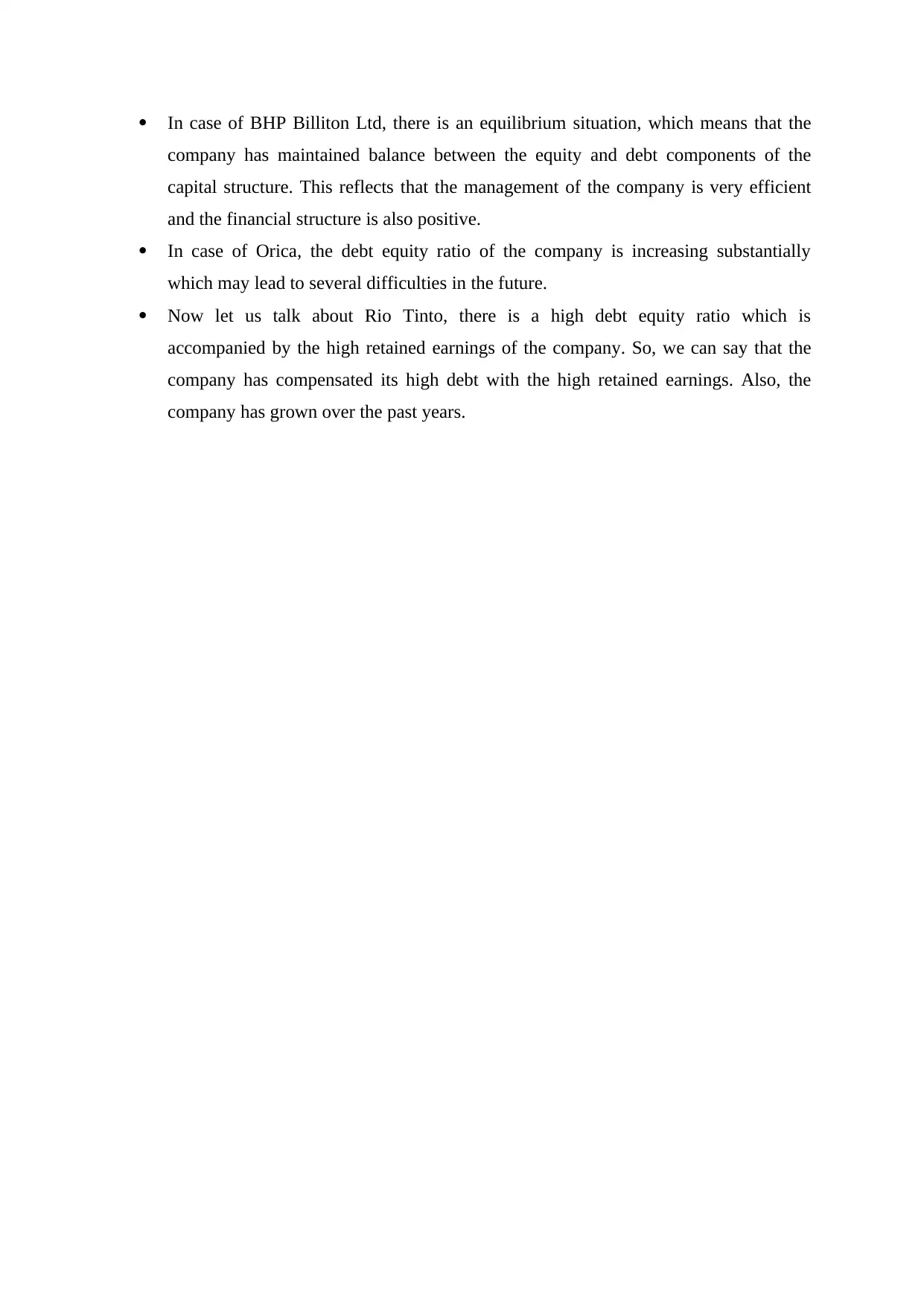
In case of BHP Billiton Ltd, there is an equilibrium situation, which means that the
company has maintained balance between the equity and debt components of the
capital structure. This reflects that the management of the company is very efficient
and the financial structure is also positive.
In case of Orica, the debt equity ratio of the company is increasing substantially
which may lead to several difficulties in the future.
Now let us talk about Rio Tinto, there is a high debt equity ratio which is
accompanied by the high retained earnings of the company. So, we can say that the
company has compensated its high debt with the high retained earnings. Also, the
company has grown over the past years.
company has maintained balance between the equity and debt components of the
capital structure. This reflects that the management of the company is very efficient
and the financial structure is also positive.
In case of Orica, the debt equity ratio of the company is increasing substantially
which may lead to several difficulties in the future.
Now let us talk about Rio Tinto, there is a high debt equity ratio which is
accompanied by the high retained earnings of the company. So, we can say that the
company has compensated its high debt with the high retained earnings. Also, the
company has grown over the past years.
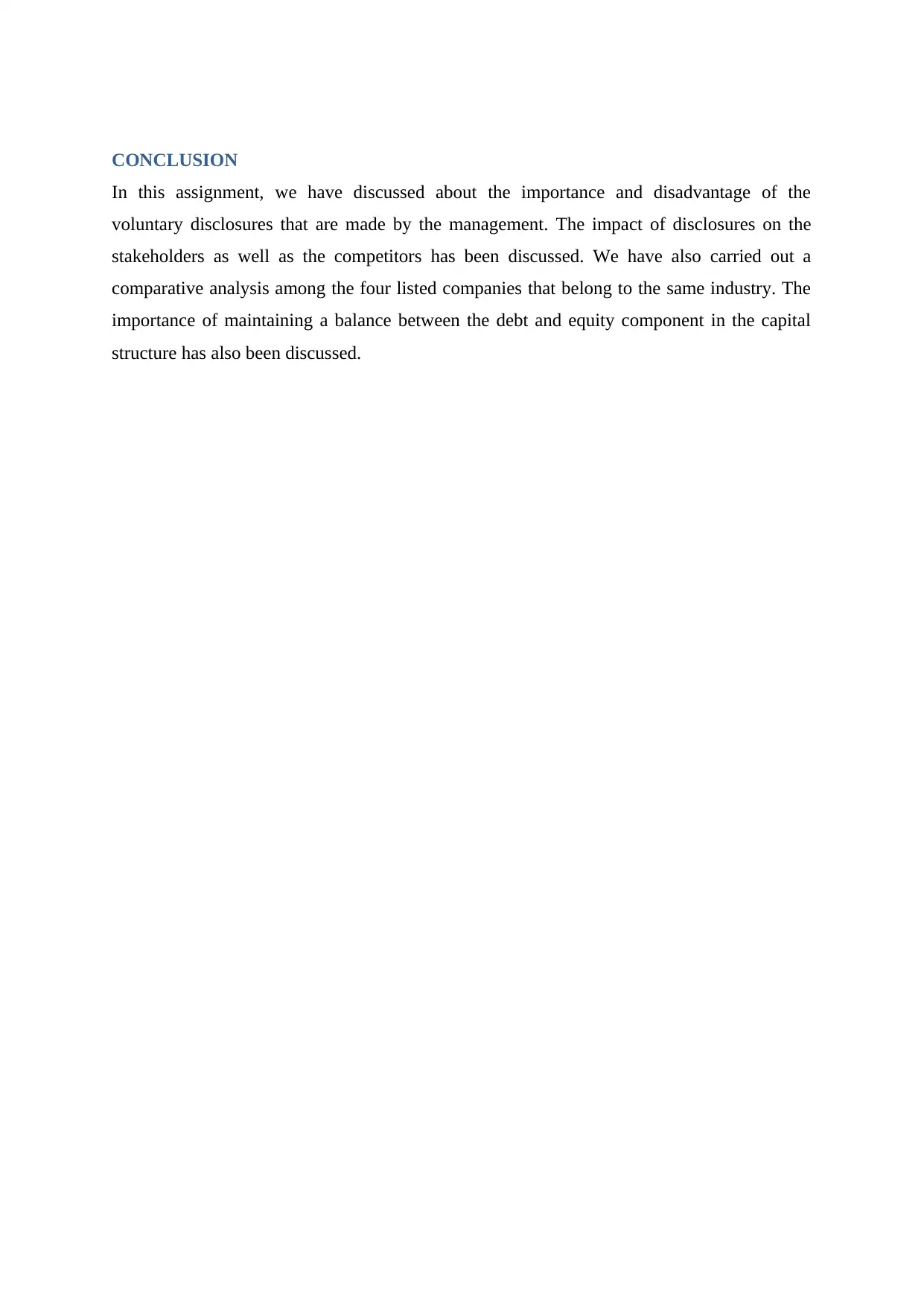
CONCLUSION
In this assignment, we have discussed about the importance and disadvantage of the
voluntary disclosures that are made by the management. The impact of disclosures on the
stakeholders as well as the competitors has been discussed. We have also carried out a
comparative analysis among the four listed companies that belong to the same industry. The
importance of maintaining a balance between the debt and equity component in the capital
structure has also been discussed.
In this assignment, we have discussed about the importance and disadvantage of the
voluntary disclosures that are made by the management. The impact of disclosures on the
stakeholders as well as the competitors has been discussed. We have also carried out a
comparative analysis among the four listed companies that belong to the same industry. The
importance of maintaining a balance between the debt and equity component in the capital
structure has also been discussed.
⊘ This is a preview!⊘
Do you want full access?
Subscribe today to unlock all pages.

Trusted by 1+ million students worldwide
1 out of 14
Related Documents
Your All-in-One AI-Powered Toolkit for Academic Success.
+13062052269
info@desklib.com
Available 24*7 on WhatsApp / Email
![[object Object]](/_next/static/media/star-bottom.7253800d.svg)
Unlock your academic potential
Copyright © 2020–2025 A2Z Services. All Rights Reserved. Developed and managed by ZUCOL.



